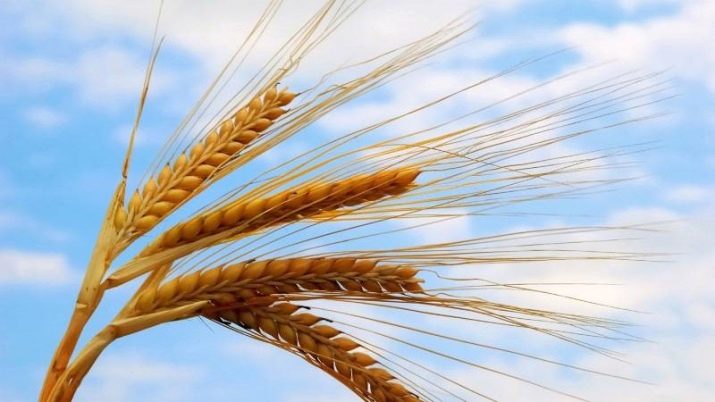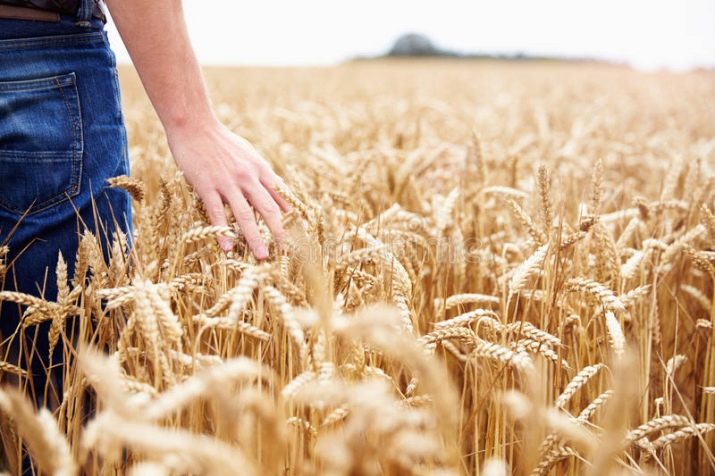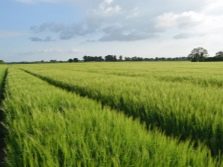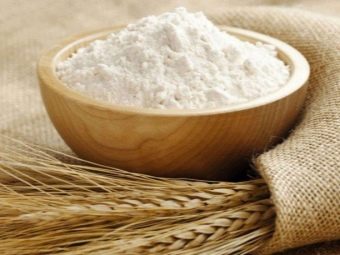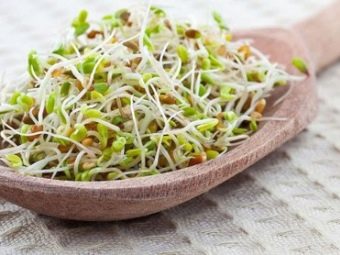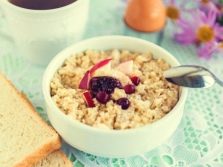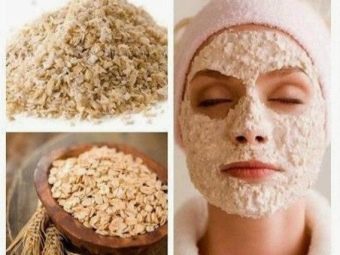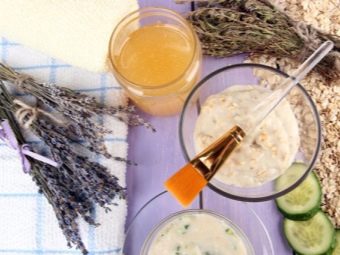Wheat: calories and composition, benefits and harms

Wheat is one of the few agricultural crops, without which modern civilization simply cannot be imagined. It can be clarified that this is not the only “bread” culture, however, the unpretentiousness and taste characteristics of the grains of this particular plant have gained maximum popularity, if not in the whole world, then in the temperate zone, where today there are the most developed states. However, many of us are accustomed to seeing wheat exclusively in the form of bread, but few are familiar with grain directly.
Main characteristics
Wheat is a culture cultivated several thousand years ago, therefore in our country it is impossible to find a person who would not see the wheat field even in the cinema. However, a visual contact for familiarization would be enough for a specialist, but an ordinary person should figure out what kind of plant is in front of him.
What does a plant look like?
Wheat is completely different varieties, and therefore the specific indicators of the description can vary significantly, but still the general name for all these plants was given for a reason - they really have more in common. To begin with, it should be noted that wheat belongs to the family of cereals, that is, it is, roughly speaking, grass with characteristically pronounced seeds in spikelets - these very grains attracted the attention of our distant ancestors at one time. The culture is spinous, that is, each grain has a characteristic and rather stiff mustache.
The stem, depending on the specific type of wheat, may be as modest as 30 cm, and much more significant one and a half meters. The plant rises vertically up, despite the fact that its knotted stem inside is empty. The leaves, like any other plant, are present, but they are relatively few conspicuous, because both the color and the shape resemble the stem itself, not too far from it. As the plant as a whole differs in dimensions, so also are its spikes, whose length can be from 4 to 15 cm.
Yield
In the wild, wheat is not so rare, but the complexity of its cultivation lies in the fact that a limited area is required to collect the largest possible crop. Since we do not experience a shortage of bread, it means that this can be achieved, but a truly large amount of grain can be harvested only under numerous conditions. There are many factors that adversely affect the volume of the crop. For example, wheat likes conditionally average humidity, without obvious bends, and therefore excessively rainy weather and drought will harm it to the same extent.
A healthy plant grows vertically upwards, otherwise it simply will not survive, and therefore strong winds for culture are also the enemy. Finally, not only people appreciated all the advantages of this cereal - numerous pests are also not averse to eat, and such a plant is also affected by diseases.
Planting seeds should be exclusively in good, fertile soil, carefully follow the agrotechnology and ensure that weeds do not create much competition to the crops.
With the seemingly excessive vulnerability, wheat is not for nothing remains one of the most popular cereals - it has enough advantages due to which humanity has been using it for thousands of years. Such, for example, is the low threshold of fallability, because it is one thing to grow a plant, and another is to collect the grain with convenience, not picking out every single grain of soil. In addition, wheat tolerates cold snaps, typical of the temperate zone even in summer, and the dry winds typical for the steppes, which do not affect the yield, do not frighten her.
In fact, absolutely all of the factors listed, including the actual variety of wheat, have a direct impact on the total yield, however, certain norms still exist. Approximately 40 centners per hectare is considered an average, although it is worth doing a discount on the same climate.
How does it grow, when does it ripen and how is it harvested?
Wheat is grown almost all over the world, its crops are insignificant except in Africa, where it is inferior to other edible crops, and Antarctica, where it is problematic to grow anything other than moss. At the same time, the process of cultivation can take a lot of energy, but with the right attitude brings a tangible profit, because the number of people willing to grow this crop does not decrease.
To the grass to grow well and give a rich harvest, you need to start to plant it in the right place. It is believed that the most fertile soil for seeds will be the soil where perennial grasses have grown before, but after sunflower it is not necessary to sow with wheat the plot exactly - its remains will act as a weed. At the same time, wheat is also demanding of nutrition, and the soil on which it grows must have an average level of acidity and well pass water.
It is necessary to prepare the soil long before planting young wheat - everyone knows that it is desirable to plow it, but not everyone knows that the procedure has at least five stages, each of which has its own name. The task of all these manipulations is, in particular, to ensure the non-growth of seeds remaining from the precursor culture, as well as to ensure sufficient soil friability for the water to flow well without accumulating too much. Even the recommended plowing depth is calculated - it is 20 cm.
Before planting, the treatment goes through not only the field, but also the grains - in particular, they are sorted, discarding the damaged ones, and treated with compounds designed to protect each grain from diseases. In some cases, additional processing is carried out with superphosphate - as a rule, such a move provides a significant increase in yield. In the modern world, planting is carried out exclusively with the help of technology, while those models that minimally tamp the soil under them should be chosen.
The exact timing of when green wheat is planted and blooms is highly dependent on the local climate, but on the whole, the planting takes place no later than mid-spring. After that, crops will have to be carefully looked after, and feeding with phosphorus, potassium and nitrogen will be of particular importance, because culture, as already mentioned, is very fond of intensive nutrition. Of course, the measure needs to be known even here, since the abundance of nitrogen affects most plants, and wheat is no exception. Do not forget also about the constant protection of the field from pests.
Wheat is a completely different crop that can be allowed to overripe. As a rule, the grains begin to rot from the slightest rain, and the stems with mature spikelets quickly begin to crumble, after which the plant completely "falls", and then there can be no question of a productive harvest. For this reason, wheat is harvested from the fields for one week after the grains ripen.
It is also possible to remove the grain in any weather, since in the rain the grain becomes wet and becomes more vulnerable to rot.
Considering the need for urgent harvesting, in the case of wheat, this process is one of the most mechanized — wheat fields massively cover reapers and combine harvesters for a few weeks. Harvested grain requires proper storage conditions, since it is also subject to various problematic factors. That is why in the shortest possible time it is delivered to elevators and special granaries, where the correct temperature and humidity level are maintained with a constant natural draft.
Varieties
As is often the case with heavily used crops, grain is carefully classified to determine for what purpose it is best suited. Some varieties are specially deduced precisely in order to give predominantly one particular kind of grain. Of course, the largest role in the economy is played by food wheat, whose quality is on average much higher than that of ordinary wild wheat. For such a plant, an important indicator is the abundant amount of large grains, which, however, for human consumption are often sold in crushed form.
In recent years, manufacturers, paying tribute to healthy nutrition, are often followed to ensure that, as a food wheat, mainly those varieties whose composition and nutritional value are balanced are grown. Feed wheat is not at all obliged to meet such high quality requirements - it is enough for it to be nutritious and contribute to the rapid weight gain of livestock, although good yields are, of course, also welcomed. If for a person it is important not only the content, but also the appearance of the product that is consumed, then animals in this sense are much less discriminating, therefore the grass may be heterogeneous or simply “ugly”.
Finally, for a crop, as for food, a very important point is the absence of any defects - such wheat should be ideal. Moreover, if a person can sell a crushed version of grains of different sizes for food, the seeds for sowing are usually sorted and calibrated so that they are all of the same type as possible - thanks to this, the yield will be much higher.
Separately, it is worth mentioning that wheat is also classified according to the season in which it grows. The traditional and most familiar type of this plant is the so-called spring wheat - the one that grows in the “normal” season, that is, in summer. However, in recent decades, humanity, in need of a huge amount of food, has found special winter varieties that can sprout under the snow, giving the earliest possible harvest in spring. Such varieties include, for example, the “Thunder”, which is very popular in our country.
It cannot be said that spring or winter varieties have a clear advantage over their “rival” - the point is to grow both. After all, this is the only way to achieve maximum efficiency of fields with a huge harvest, collected almost year-round.
Chemical composition and caloric content
Perhaps the abundance of useful substances of cereals can not be compared with fruits and berries, which are traditionally considered to be an endless source of health, but this does not mean that there is nothing in wheat that the human body desperately needs. The chemical composition of this product is very useful for humans, although not terribly rich.
The presence of dietary fiber in wheat, which is necessary for the proper functioning of the digestive system, is especially noticeable. Only 100 grams of wheat, consumed in its pure form, provide 2/5 of the daily intake of this substance. The abundant presence of pectin in the composition also has a very positive effect on the health of the stomach and intestines, but already in a slightly different plane - this substance reduces the irritation of the mucous membrane, and therefore thanks to it, many acute diseases proceed more easily.
It seems that The vitamin-mineral complex of wheat as a whole was created specifically to make people feel young and strong as long as possible. The antioxidant properties of components such as selenium, as well as vitamin B12 and E are complemented by the ability of these substances to inhibit the development of cancer, in a timely manner by removing heavy metals from the body.Phytoestrogen also helps a lot with this reagent.
Of course, the content of microelements and vitamins in wheat is not limited to the described set, just everything else is contained here in a relatively modest amount. In any source, you can find confirmation that the cereal has a significant amount of magnesium and potassium, phosphorus and zinc, as well as linoleic acid and other amino acids. Together, these substances ensure the diversified correct operation of all systems of the human body, because wheat, even in the age of mass synthetics in the field of nutrition, remains extremely in demand for natural products, whose popularity in the coming decades is unlikely to decrease.
If we talk about the caloric content of wheat itself, then the smallest amount of energy will give 100 grams of germinated grains - their energy value is estimated at 200 kcal. For ordinary grain, regardless of the grade, this figure is already about 340 kcal, and the most calories in raw germs are 360 kcal per 100 grams. As for wheat flour, its caloric content is in the range of 312-334 kcal, and the energy value is the higher, the more qualitative the grade of flour.
The nutritional value
It should be understood that, due to the variety of varieties, wheat does not have a specific, clearly indicated nutritional and energy value. Each variety should be considered separately, but since it is quite long and still does not allow to cover absolutely all varieties of wheat, we consider these indicators in a generalized form. Proteins make up a significant part of the grain, on average, their number is about 10-14%, although there are some notable exceptions. For example, in germinated grains of proteins only 7.5%, whereas in untreated embryos their number reaches 23%.
Carbohydrates are the main substance for wheat and all products from it, but here too the proportions can fluctuate significantly. For most varieties of grain and flour, the carbohydrate content is 70-75%, but there are products with a more modest content of such substances: 42.5% in germinated grains of carbohydrates, 52% in unprocessed germs, 48% in flour. Fats make up perhaps an insignificant percentage of wheat, and in most products from this cereal its amount is within 1-2.5%. As in all other cases, untreated embryos and flour are knocked out of the total number of them - there the percentage of fat reaches 10% and 8%, respectively.
Beneficial features
There is no need even to conduct serious scientific research in order to understand that in wheat there is much more benefit for a person than harm, otherwise humankind would simply die out over the millennia of its use. Today, in an age of developed trade and the possibility of acquiring exotic food from any region of the world, some gourmets may think about refusing or significantly reducing the proportion of wheat in their diet, but this should not be done, if only because of the numerous useful properties of this cereal, which should be considered more carefully.
- Many from childhood know that eating bread is satisfying with bread. This is not surprising, because wheat, as mentioned above, is mostly composed of carbohydrates, which, moreover, are absorbed quickly and easily. As a result, the feeling of hunger is leveled out in the shortest possible time, and the resulting energy reserves are enough for a long time.
- Vegetable food containing dietary fiber, in any case, is beneficial to the human body, because it is very gentle effect on the digestive system. Such ingredients are especially indicated in case of increased acidity of the gastric juice, as they are able to reduce it. In addition, these fibers also have a certain massage effect on the walls of the gastrointestinal tract.
- A significant content of vitamin E in wheat has a positive effect on the state of the circulatory system, because this substance helps to eliminate excess cholesterol from the body. But this does not end the beneficial properties of this vitamin, because, in combination with selenium, it is able to remove radionuclides and other carcinogens from the body using an accelerated pattern.
- An important and useful component of wheat is pectin, which can be called a natural sorbent. This substance can "attract" to itself not only toxins and harmful microorganisms, but even slags, which, accumulating in the intestine, often cause the development of numerous diseases. Constant inclusion in the diet of pectin-containing products contributes to a comprehensive cleaning of the intestine and, consequently, maintaining health.
- Magnesium in combination with vitamin B12 refers to substances absolutely indispensable for the proper functioning of the nervous system. It cannot be said that wheat is the main “anti-stress” in the diet of a modern person, since there are products containing the same substances in higher quantities. However, scientists have proven that regular consumption of wheat and its products can have a positive effect on the psycho-emotional state of a person.
- Wheat and potassium are not deprived, and after all this microcell supports one of the most hard-working organs, the heart, in order. The heart muscle, unlike most other organs, works continuously and has no loosening on schedule, and it is potassium that is the substance that helps it to recover faster under such loads. The same element at the same time strengthens the vascular walls, making it a universal solution for the circulatory system. The effect of potassium on the composition of the blood has also been proven, which is normalized due to it.
- Linoleic acid, which is abundantly contained in wheat, plays the role of a peculiar metabolic regulator, since the rate of absorption of proteins, fats and carbohydrates depends on it.
However, the body is not enough just to get all these substances - you also need to properly distribute them between all systems, and in this linoleic acid is also an indispensable tool.
Numerous useful properties of wheat were noticed by mankind in those times when science in the modern sense of the word did not really exist. As a result, numerous means of traditional medicine were invented, which are mainly tinctures and decoctions that treat many different diseases - for example, atherosclerosis and diarrhea, dystrophy and constipation, anemia and flatulence, malfunctions of the digestive system and cough. Perhaps, modern pharmacology is able to offer more effective remedies for all these problems, however, they can be expensive and contain various synthetic, potentially harmful components, whereas wheat is a completely natural product and, most importantly, inexpensive.
If all the above referred to wheat grains proper, then a peculiar trend of modernity is the use of young sprouts, which are specially germinated even at home. The advantage of this version of wheat is the fact that here all the nutrients are contained in the already split form, so the human body would spend far less effort on the absorption of useful components, and the efficiency of the process would reach a maximum. A growing organism contains many things that were not found in ordinary grains, and all these substances could be beneficial for humans.
For example, the high content of vitamins of group B is able to establish the correct metabolism and provide a clearly visible beauty of hair, nails and skin. The content of vitamin C, absolutely indispensable for successful opposition to all sorts of ailments, is also increased in germinated wheat.At the same time, the amount of sugars in such a product is significantly lower than in ordinary grains, therefore germinated wheat does not pose any threat to diabetics.
An even more modern product of healthy nutrition is not even the germinated wheat itself, but the juice squeezed out of it.
In general, of course, the beneficial properties of such a substance largely duplicate the similar properties of ordinary wheat germ, but the liquid product contains less carbohydrates, and therefore the caloric content is noticeably lower, which removes many restrictions on the use of such "drugs".
Separately, it must be said that the liquid form allows using such juice as not only a drink, but also for external use - as a cosmetic. One of the most common uses is to combat skin diseases - you just need to lubricate the affected skin, and then repeat the procedure if the result was insufficient. For health and hair strengthening as a conditioner it is recommended to use the same juice from germinated wheat, in which all substances useful for hair are stored.
Another liquid product derived from this culture is wheat germ oil. The difference from both the grains and the juice of sprouts is the increased amount of polyunsaturated acids and tocopherol - an antioxidant, which allows you to maintain the youthfulness of the body and the functional state of its various systems for a longer time. Again, in many respects the healing properties of such a liquid duplicate the above, but a certain difference in chemical compositions still provides specific benefits from such a product. For example, it is considered a popular folk remedy for the healing of burns and wounds, has a positive effect on the function of the genitourinary system and helps keep muscles in shape.
Contraindications and harm
Wheat, as well as flour and other products from it, is such a massive and popular product that it is difficult to even imagine how a cereal may be contraindicated. Nevertheless, on our planet there is no completely harmless food, because even ordinary wheat bread could theoretically have restrictions in consumption. Of course, The main reason why eating wheat products should be limited is the high calorie content of such food. On the one hand, the high content of dietary fiber helps to improve intestinal motility, due to which carbohydrates are not fully absorbed, on the other, with a large amount of baked food, no fiber will help to keep the figure normal.
Separately, it should be noted that people more often lean not just on bread, but on sweet pastries made from wheat flour in the form of buns and similar products, in which the carbohydrate content is even higher. For this reason, people who are overweight or have a marked propensity for its collection of wheat and food from it may be contraindicated. At the same time, the abundant use of wheat can adversely affect even a healthy person - the result may be discomfort in the stomach, flatulence and constipation, all of which affect the above described products and by-products.
With all the beneficial and protective effects on the digestive system, wheat products are also contraindicated in the postoperative period, if the surgery involves the digestive system. Contraindications may well be chronic problems with the stomach or intestines.
Wheat allergy (usually gluten contained in it) is very rare, but it is still theoretically possible. It is clear that such a diagnosis immediately puts an end to the use of any products made from wheat flour, as well as on any other by-products of wheat described above.In addition, in some cases, this cereal can increase blood pressure, which for hypertensive patients is fraught with a serious deterioration of health. However, for people with a similar diagnosis, the doctor usually makes up a rather detailed diet, which says that each product can or cannot be consumed. Therefore, those people to whom products based on wheat flour can not be consumed, usually aware of this in advance.
Separate side effects may result from the use of wheat germ, which contains a special substance - lectin. The degree of danger of this substance has not yet been accurately identified, but it is considered that it has a rather destructive effect on the human body, as it provokes problems in the field of metabolism, and also can disrupt the functioning of the heart, liver and endocrine system. The oil obtained from wheat sprouts is considered practically harmless compared to other by-products, although some experts believe that it has a rather bright urinary and choleretic effect.
Any products with a similar effect on the human body are dangerous in the presence of stones in the gall bladder or bladder. Therefore, even if they are not contraindicated, at least they require very careful application.
Application
Imagine the modern world without the use of wheat is very difficult, because it is products from the grains of this plant are the main source of vegetable proteins in the world. At the same time, perhaps, wheat and its offal should no longer be taken solely as food, since they are also used in cosmetology, although it is worth starting, of course, from food use. Today, wheat germ, popular with healthy food lovers, has become an ingredient in various cereals, snacks and salads, but the juice obtained from such seedlings is often added to cocktails based on fruit juices to improve their taste.
The most popular product of wheat grain processing is flour. For many nations of the world, pastries from such raw materials occupy an important place on the daily table, but even those nations in which wheat cultivation is not a tradition have to use wheat flour at least partially. The fact is that the characteristic stickiness of wheat flour is characteristic only for the powder from this cereal - it is provided by gluten, also called gluten. From rice, millet or buckwheat flour in its pure form to bake something is very problematic, because without the addition of wheat flour, the product simply will not "hold".
By the way, the grains are not always crushed to the state of flour - they can be crushed wheat grits. Naturally, the most obvious dish of such raw materials is ordinary wheat porridge, but in fact, cereals are perfectly combined with a variety of ingredients that allow for refinement in culinary delights. Wheat groats go well with other cereals (made from corn, peas, chickpeas), vegetables (tomatoes, broccoli), some types of cheese and meat, as well as eggs and white wine. A large number of different seasonings are able to give wheat groats a new, unique taste. The peoples of the world make it the most unusual dishes that the language does not turn to be called just porridge.
In some cases, the grass is not even crushed, leaving as a whole grain. In most cases, wheat grain is used to prepare various variations of porridge, which can be prepared both with fundamentally different ingredients, and mixed with other cereals. Not to mention that the grain in combination with the husk is used as a technical crop for livestock feed.
The only problem in using wheat as food is the presence of gluten, which for many people is a strong allergen. It should be noted that even this moment shows how important wheat is for humanity.
As allergy sufferers usually do not eat fundamentally other products, they simply have to look for analogues of generally accepted products specially made from other types of raw materials. Bread, macaroni, cookies, even flour for home-made meals by yourself - all of these products are made not only from wheat, but in fact are just an imitation of the original recipe, which involves the use of this particular cereal.
If we talk about cosmetology use, then most actively people use the properties of wheat, allowing to improve the condition of the skin, nails and hair. Any wheat by-products are suitable for external use, however, the most appropriate choice is in favor of seed oil. This liquid in a concentrated form contains absolutely all the antioxidants inherent in wheat, and in fact such substances help to establish a metabolism and fully nourish the skin.
Wheat flour is also used as a skin-healing product, however, it is more often used not in pure form, but as part of more complex recipes - for example, milk based on white wines. Thanks to such a recipe, an optimal set of useful and nutrients in the right proportions is achieved, because the cleansing and narrowing of the pores, as well as the skin nutrition is optimal. For hair care, they often make special masks in which, in addition to wheat germ oil, cream is used in combination with lemon juice.
For external application to the skin using conventional wheat bran, which are used for feeding domestic animals. This substance helps cleanse and nourish the skin, and also effectively relieves inflammatory processes. A similar recipe is shown for people with oily skin, but numerous reviews indicate that the potential scope of this mask is not limited to any one type of skin.
For the benefits and dangers of wheat germ, recipes and tips on eating, see the following video.



